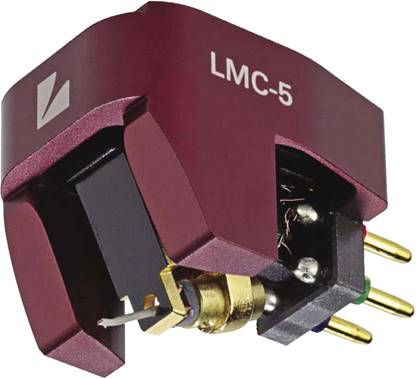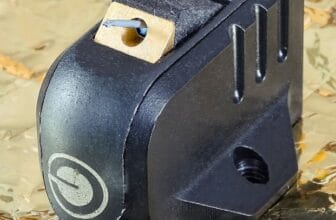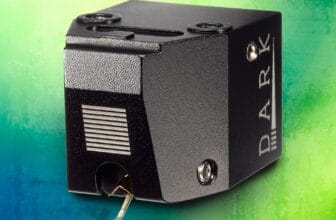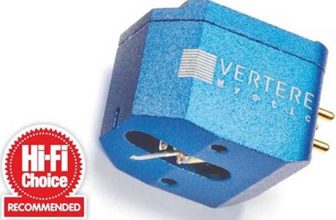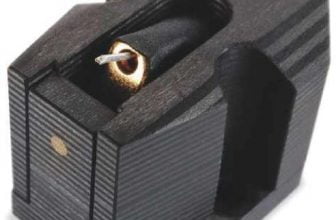LUXMAN LMC-5 Review: Deep Red
Luxman’s LMC-5 moving coil cartridge runs deep, finds Noel Keywood. Read our LUXMAN LMC-5 Review.
Here’s a moving coil cartridge that’s unusual in being usual. Yes, completely normal. No new technologies, just a vanilla design nicely optimised I found.That is Luxman’s LMC-5 under review here, price £ which places it amongst premium MCs, if not esoterica.
Luxman describe it as having a conventional MC “engine” as they call it, but is more conventionally called a “generator” – of the coil and magnet variety, as used in all pickup cartridges with electromagnetic generators (MCs and MMs), excluding budget ceramics and rare optical types.
The LMC-5 engine comprises two copper wire coils – no gold plating – wound on an iron yoke sitting in a field established by a body-mounted Samarium Cobalt magnet. Luxman quote a coil impedance of 4.7 Ohms at 1kHz – a common value. It’s usual to quote a load x10 greater than the generator and this they do, saying a load of 40 Ohms or more is suitable, making the cartridge compatible with standard 100 Ohm MC phono stages. Output is healthy: they quote 0.4mV, suitable for most MC phono stages; super high gains are unnecessary.
The generator assembly sits in a body pared down for light weight and made asymmetric for low resonances, externally anodised ruby red. Like most MCs left channel ground (green) is not connected to the bodywork so the cartridge can be connected up balanced if desired. Checking this out I found that the inner body is not metal: the fixing screws were not electrically connected to each other, nor the metallic outer shell.
I connected up unbalanced, through our Icon Audio PS3 valve phono stage, probably because I associate Luxman with a Lux 40W per channel valve amplifier I owned long, long ago, designed in Japan by Tim Paravicini before he returned to the UK to start EAR. Luxman were well known for this amplifier at a time when valves were dying out – or so it seemed – and they still make them today, for a “natural sound free from exaggeration” they say. I see the same thinking within the LMC- 5 cartridge. The PS3 I guessed would be a natural fit.
The cartridge comes in a small hinged case together with three pairs of M2.6 stainless steel screws, 5mm, 8mm, 10mm thread length, plus two clear nylon protective washers and a hex key. There are no nuts because the body comes with threaded inserts, making fixing easy. There are no accessories either, such as stylus brush.
A body weight of 8.5gms sits comfortably in the centre of the 6gm-10gm weight range most arms accept. Quoted tracking force range is 2.lgm-2.3gm with 2,2gm recommended and that figure is now commonly used with moving coil cartridges in this price category. Ortofon’s esoterica like the SPU series needs 4gm but this is an exception.
I was surprised that with boron rod cantilevers becoming common in high performance cartridges Luxman use a conventional parallel sided aluminium tube in this design – not even a conical tube. Attached is a tiny, nude Shibata profile stylus – my preferred shape and now very popular generally, a trend that makes sense then!
SOUND QUALITY
The LMC-5 was installed into our SME309 arm on Timestep Evo modified Technics SL- 1210 Mk2 turntable, set to the recommended 2.2gm downforce then run in. Mostly I used it with our Icon Audio PS3 Mkll
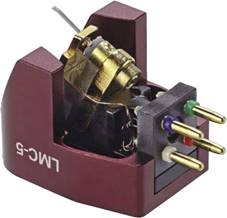
The skeletal outer shell is machined from aluminium and anodised red. The stylus is clearly visible for ease of cueing.
valve phono stage (with input transformers) as mentioned earlier, feeding a PrimaLuna EVO 300 Hybrid amplifier driving Martin Logan ESL-X hybrid electrostatic loudspeakers through Chord Company Signature Reference screened loudspeaker cables. There was just reason to change over to a Pro-Ject Phono Box RS2 solid-
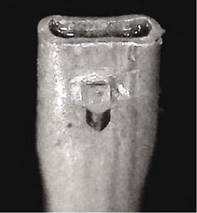
The stylus has a rectangular shank for accuracy of orientation on the cantilever. Note how the alloy tube has been crimped to provide a flat surface.
state phono stage with balanced input for an alternative sound, as I’ll explain.
My initial and enduring impression of the LMC-5 was one of laconic smoothness and depth in absolutely classic fashion. With King of the Mountain from Aerial I was greeted by a spacious sound stage from which Kate Bush sang centre-stage with convincingly natural tone. Images across the stage were stable in position and generous in body, and I luxuriated in a wonderfully tactile delivery that was every bit what you’d hope for from a quality MC cartridge, with word “refined” appended. By that I mean no sign of top end tizz or any type of “exaggeration” as Luxman would put it. So right on message. This is an album with an easy balance instrumentally, Kate Bush not being into heavy Rock, so I ignored its sonic gentleness.
With the Syd Lawrence Orchestra playing Sing, Sing, Sing, from Big Band Spectacular (Chasing the Dragon), the drum work was firm, powerful and deep with the lovely sense of stage depth expected from a valve phono stage boasting input transformers.
After playing a slew of LPs I become aware that some might want less “gentleness” and a bit more bite, plus top-end sparkle, so decided to change over to our Pro-Ject Phono Box RS2 phono stage, connected up balanced to the SME after an arm-lead change.This swapped the smooth, deep sound for one with vivid mid-band insight.Trumpets and trombones moved forward and developed blare, but were also purposefully resolved.The drum work gained speed whilst losing some low-end weight, the general milieu changing substantially: I now heard a more forward and sharper etched delivery from the LMC- 5 but still one relatively easy going and neutral in character, if with lessened stage depth due to the absence of transformers in front of valves.
These changes showed me the Luxman has a mild, self effacing nature, a gentle easiness that submits to changes without becoming sonically unbalanced. This is in contrast to currently- popular boron rod cantilevers that technically surpass all else, including the simple aluminium tube of the LMC-5, but have a mechanically hard sound that is, I feel, soul-less and best not partnered with ‘hard’ amplifiers.
My personal preference is for conical aluminium cantilevers, in Ortofon’s Cadenza Bronze for example, that bring just a little
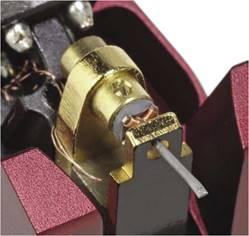
Visible just behind the cantilever hinge are two of the four micro-coils that sit on an iron yoke. Behind lie parts of the magnetic circuit. At front is a pole plate.
more speed and definition to the sound of the commonly used, parallel sided 0.5mm alloy tube Luxman employ here. But the merit of Luxman’s choice is soft neutrality.
I was always aware of the civility of the sound, how it carried no offence, no colour. But
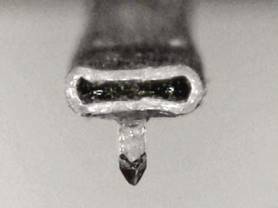
The dark tip appearance suggests it can been profiled by laser, rather than grind wheel, the original way to profile a Shibata – purposed for 1970s CD4 discs.
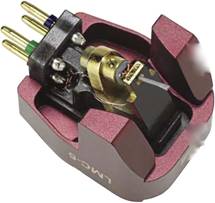
The inner body is non- metallic, isolating the body from the arm headshell, tests showed.
when spinning Rosella Caporale singing Time to Say Goodbye from Two Nations One Heart, as a check of performance in the run-out grooves where stylus life gets difficult, the composure of the LMC-5 made me realise just how good its Shibata stylus is, instruments staying steady and clear in the mix, where there is commonly a slight sense of jitter within sound stage images. The song glided through to her vocal crescendo with confidence, ending as if nothing was different from outer grooves. The LMC-5 trod with care and dexterity at all times, sounding adept yet balanced.
CONCLUSION
For anyone wanting classic moving coil sound, free of funnies such as bright treble or the sterility that comes from boron, Luxman’s LMC-5 is worth hearing. It has been finely honed to be easy going yet truthful – and this was very obvious to me at all times. I didn’t squirm once! Instead I enjoyed listening to it, admiring its sense of smoothness and depth. What more could you want?
Well, one obvious thing is lower price. As lovely as this cartridge is the price tag is above that of Ortofon’s Cadenza Bronze, price £ that is simply better, technically and in sound quality.There are other options from Denon and Audio Technica that cost far less, the latter’s AT- OC9XSH that I also use regularly coming in at £. Luxman are plunging into a competitive field with this one and as lovely as it is, the price is on the high side.Well worth considering though, if you would like to hear a classic MC that is refined and lovely in its sound, rather than hard and fast.
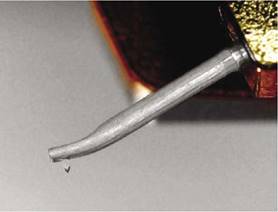
A conventional parallel sided aluminium alloy tube, crimped and bent at the end, a common manufacturing technique used on inexpensive cartridges.
MEASURED PERFORMANCE
Luxman publish a frequency response for their LMC-5 moving coil cartridge, using a JAS AD-1 (Japanese Audio Society) test disc. Our response, using a reference JVC TRS-1007 test disc and shown here, was nearly identical, a surprising similarity showing just how accurate vinyl can be. The point they are making is that the LMC-5 is as tonally accurate as CD, fully matching the standard now reached by companies such as Ortofon and Audio Technica. There was little tracing loss on inner grooves our analysis shows (red trace) due to the Shibata’s ability to trace short mechanical wavelengths.
Tracking of the 300Hz tones on CBS-STR112 test disc was secure up to a high value of 80 muym peak amplitude, at 2.2gm recommended down force. At 1kHz where tip mass and acceleration become important, it managed a high 18cms/sec, mistracking marginally at 20cms/sec and failing the 25cms/sec torture track on B&K2010 test disc that few cartridges manage. In all then, a good tracker.
Output was normal enough, measuring 0.37mV at 3.54cms/sec – a value that is nether high nor low, being x10 less than a typical MM, as expected.
Distortion was unusually low on a 45 muym lateral cut (CBS STR-112), measuring 0.4% against a common 1% value. On vertical modulation this jumped to 4% due to a high measured vertical tracking angle (VTA) of 27 degrees (DIN 45542 test disc), a not uncommon problem. Being correlated second harmonic it’s not as bad as it sounds. Optimal is 22 degrees.
The LMC-5 is a conventional moving coil cartridge, with tubular aluminium alloy cantilever, well engineered to be accurate and problem free measurement showed. NK
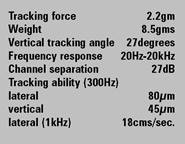

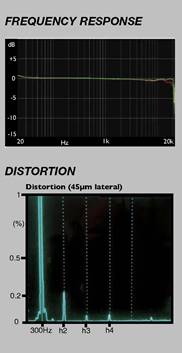
OUTSTANDING – amongst the best
VERDICT
FOR
– balanced and refined sound
– superb on inner grooves
– deep sound stage
AGAINST
– lacks visceral impact
IAG
+44 (0)1480 447700
www.quad-hifi.co.uk
